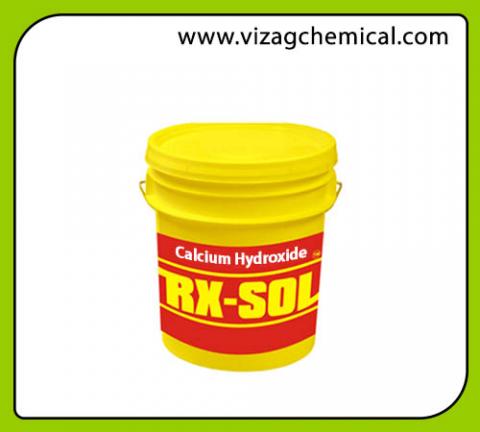Primary tabs

Calcium Hydroxide
Calcium hydroxide (traditionally called slaked lime) is an inorganic compound with the chemical formula Ca(OH)2. It is a colorless crystal or white powder and is obtained when calcium oxide (called lime or quicklime) is mixed, or slaked with water. It has many names including hydrated lime, caustic lime, builders' lime, slack lime, cal, or pickling lime. Calcium Hydroxide is use as a raw material for many chemical processes that require a highly reactive, high purity, consistent product. The small particle size and top size make it an excellent choice for many applications. RXSOL Calcium Hydroxide prepared to customer specifications.
Soft, white crystalline powder with an alkaline, slightly bitter taste. Used for mortar, cements, white wash, soil conditioner, drying hold, and cleaning.
Calcium Hydroide has many application including Mortar, plasters, cements, calcium salts, causticizing soda, depilatory, unhairing of hides, whitewash, soil conditioner, ammonia recovery in gas manufacture, disinfectant, water softening, purification of sugar juices, accelerator for low-grade rubber compounds, Shipping , Marine and petrochemicals.
Calcium Hydroxide, is a versatile product with interesting properties that brings great benefits for industry, construction and the environment because it can be applied in several formats.Calcium hydroxide which to some may sound a little outlandish created in a laboratory and to others like something from science fiction, is almost omnipresent in daily life. It is obtained through a process which hydrates calcium oxide, in this reaction the hydration of the lime generates heat, something that favours, in many applications, the drying and disinfecting of the materials that are treated.
Handling :
Keep container dry. Do not ingest. Do not breathe dust. Never add water to this product. In case of insufficient ventilation, wear suitable respiratory equipment. If ingested, seek medical advice immediately and show the container or the label. Avoid contact with skin and eyes. Keep away from incompatibles such as acids.
Storage :
Keep container tightly closed. Keep container in a cool, well-ventilated area.
Chemical Characteristics
| Parameter | Test Method | Test Result |
| Calcium Hydroxide Ca(OH)2 | ASTM C-25 | 98.0 % min |
| Iron Oxide Fe2O3 | ASTM C-25 | 0.30 % max |
| Aluminium Oxide Al2O3 | ASTM C-25 | 0.20 % max |
| Sulfur S | LECO | 0.16 % max |
| Insoluble matters | 0.5 % max | |
| Chloride ppm Cl | LECO | 320 max |
| Magnesium Oxide MgO | LECO | 0.7 % max |
| Phosphate ppm PO4 | LECO | 600 max |
| Silicon Oxide SiO2 | LECO | 0.50 % max |
| Carbon Dioxide, wt % CO2 | LECO | 0.85 % max |
| Humidity % H2O | ASTM D-95 | 1.0 % max. |
|
Appearance |
White Powder |
|
Odor |
Odorless |
|
Density |
2.211 g/cm3, solid |
| Calcium (Ca) | 53.50% |
| Crystalline Silica | <0.1% |
|
Acid Insoluble Substances |
0.07% |
| Silica (SiO2) | 0.2% |
Products based on calcium hydroxide have a surprisingly wide variety of applications. The fact is that slaked lime has been used since time immemorial and with amazing results. Some of imprtant application as below -
- Waste Water/Water Treatment
- Construction
- Flue Gas Treatment
- Chemical Processes and Chemical Reactions
- Petrochemicals
- Calcium Salts (citrates, phosphates, stearates),
- Acid Neutralization
- Chemical Reactions
- Calcium Enrichment (food, pharmaceutical, neutraceutical).
Calcium hydroxide can be found in the food industry providing calcium and as a pH modifier, as well as in the management of gases, as it has a high effectivity in the capture of acidic pollutants from industrial smoke and vapours. It is also an additive in feeds improving animal nutrition, and is used in animal-pens for its disinfecting power, lowering the number of pathogens and virus. In the sugar-industry it can be used to precipitate out impurities and to obtain purified sucrose.
It also brings benefits in sludge treatment as it is an exceptional aid in the elimination of micro-organisms and bacteria which at the same time neutralizes bad smells.Its properties are especially useful for water treatment, because it acts as a clarifier, a coagulant, a neutralizer and for the precipitation of dissolved pollutants.
